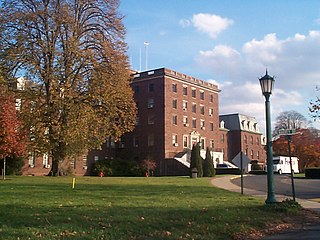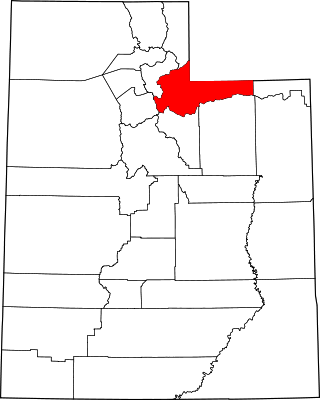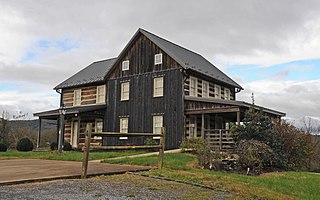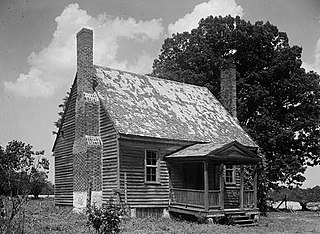
Connecticut Valley Hospital in Middletown, Connecticut, is a public hospital operated by the state of Connecticut to treat people with mental illness. It was historically known as Connecticut General Hospital for the Insane. It is a 100-acre (40 ha) historic district that was listed on the National Register of Historic Places in 1985.

Rose Hill Cemetery is a 50-acre cemetery located on the banks of the Ocmulgee River in Macon, Georgia, United States, that opened in 1840. Simri Rose, a horticulturist and designer of the cemetery, was instrumental in the planning of the city of Macon and planned Rose Hill Cemetery in return for being able to choose his own burial plot. The cemetery is named in his honor.

This is a list of the National Register of Historic Places listings in Summit County, Utah.

The South Starksboro Friends Meeting House and Cemetery is a historic Quaker meeting house and cemetery on Dan Sargent Road in Starksboro, Vermont. Built in 1828 and last significantly updated in the 1870s, it is the oldest Quaker meeting house in Vermont, and continues to see regular use. It was listed on the National Register of Historic Places in 1985.

St. John's Evangelical Lutheran German Church and Cemetery, also known as St. John's Lutheran Church and Cemetery and as White Church, is located in the vicinity of Hayes Center in Hayes County, Nebraska. It was listed on the National Register of Historic Places in 1985. The listing includes a 10 acres (4.0 ha) area with the church as a contributing building and the cemetery as a contributing site.

The Huffman Distillery and Chopping Mill is an historic complex of buildings which is located in Somerset Township, Washington County, Pennsylvania, United States.

Cross Roads Presbyterian Church and Cemetery and Stainback Store are historic buildings near Mebane, Alamance County, North Carolina. The church was built in 1876, and is a 1 1/2-story, brick vernacular church building. The Stainback Store, across from the church, was built about 1888, and is a simple two-story gable front frame structure built from materials of the original church building and session house from about 1792. Located near the church is the contributing cemetery established about 1792.

Rock Hill Farm, also known as the Davis-Stauffer Farm Complex, is an historic, American home and farm and national historic district located in Montgomery Township in Franklin County, Pennsylvania.

Ross Common Manor is a national historic district that is located in Ross Township, Monroe County, Pennsylvania.

The Jervis Gordon Grist Mill Historic District, also known as the Milford Grist Mill and Rowe's Mill, is an historic grist mill and national historic district that are located in Milford, Pike County, Pennsylvania.
Macon is an unincorporated community in Fayette County, Tennessee, United States. The community is located at the intersection of two state highways, State Route 193 and State Route 194. Its ZIP Code is 38048.

Pleasant View, also known as Trabue's Tavern, is a historic plantation house located near Midlothian, Chesterfield County, Virginia. The original section was built about 1730, and consists of two parts—an early 1+1⁄2-story western wing with a lean-to and a later two-story eastern wing with a one-story rear lean-to. Both sections are frame structures with gable roofs. Also on the property are several contributing buildings: an outhouse, well house, dairy, smokehouse, two kitchen buildings, schoolhouse, and family cemetery. Macon Trabue installed a wrought iron fence around the cemetery in the mid-nineteenth century.

Nuckolls-Jefferies House, also known as the Nuckolls House and Wagstop Plantation, is a historic plantation house located near Pacolet, Cherokee County, South Carolina. It was built in 1843, with alterations in the 1870s or 1880s. It is a 2+1⁄2-story, frame residence in a combined Greek Revival / Classical Revival style. It is clad in weatherboard and sits on a stone foundation. The front facade features a two-tiered central, pedimented portico supported by two sets of slender wooden posts. The rear of the house has a two-story ell, built during the 1996 restoration. Also on the property are three contributing outbuildings: a small, one-story log gable-front building that dates from the mid-to-late 19th century that served as the farm's smokehouse, a 1+1⁄2-story gable-front frame barn, and another frame gable-front barn with side shed lean-to extensions.
Old South Mebane Historic District is a national historic district located at Mebane, Alamance County, North Carolina. It encompasses 308 contributing buildings in a primarily residential section of Mebane. The district primarily includes one- to two-story frame residences in a variety of vernacular and popular architectural styles including Colonial Revival, American Craftsman, and Queen Anne styles. The earliest dwellings date to about 1900.

Cascine is a historic plantation complex and national historic district located near Louisburg, Franklin County, North Carolina. The district encompasses 12 contributing buildings, 4 contributing sites, and 3 contributing structures. The main house was built about 1850, and is a large two-story, Greek Revival style frame dwelling, in the manner of Jacob W. Holt, with Gothic Revival style influences. Also on the property is a small, one-story frame dwelling dated to about 1752. It was repaired and refurbished in the mid-20th century. Also on the property are the contributing brick kitchen, frame stable, granary, carriage house, family cemetery, slave cemetery, remains of slave quarters, tenant house, six log and frame tobacco barns, grist mill complex, and archaeological sites.

Irving Park Historic District is a national historic district located at Greensboro, Guilford County, North Carolina. The district encompasses 164 contributing buildings, 5 contributing sites, 2 contributing structures, and 2 contributing objects in an affluent planned suburb of Greensboro. It developed around the Greensboro Country Club. The houses were largely built between 1911 and the 1930s and include notable examples of Colonial Revival, Tudor Revival, and Classical Revival-style architecture. Notable buildings include the first Robert Jesse Mebane House, the Cummins A. Mebane House, the Lynn Williamson House, the first J. Spencer Love House, the Aubrey L. Brooks House, Carl I. Carlson House, the Van Wyck Williams House, the Lavlson L. Simmons House, the Albert J. Klutz House, the Irving Park Manor Apartments, McAdoo-Sanders-Tatum House, the Alfred M. Scales House, and the Herman Cone House.

The Central Vinton Residential Historic District is a nationally recognized historic district located in Vinton, Iowa, United States. It was listed on the National Register of Historic Places in 2012. At the time of its nomination it contained 266 resources, which included 184 contributing buildings, one contributing structure, and 81 non-contributing buildings. Most of the contributing buildings are houses, and outbuildings. Second Avenue retains its brick paving and it is the contributing structure. Vinton is the county seat of Benton County, and this is one of its most affluent neighborhoods. Because the town is a center of commerce and government, it started to grow in the mid-to-late-nineteenth century.

The Macon Historic District is a historic district in Macon, Georgia that was listed on the National Register of Historic Places in 1974 and was expanded in 1995. The original listing covered 587 acres (238 ha) and included 1,050 contributing resources; the increase added 101 acres (41 ha) and 157 contributing resources.

The District 6 School House is a historic school building at 73 Cemetery Circle in Lyndon, Vermont. Built in 1857, it served as a school until 1900, and saw use in the 20th century as a garage, storage facility, and museum. It was listed on the National Register of Historic Places in 2006.

The Brown Street Historic District is a nationally recognized historic district located in Iowa City, Iowa, United States. It was listed on the National Register of Historic Places in 1994, and its boundaries were increased in 2004. At the time of the boundary increase it consisted of 246 resources, which included 201 contributing buildings, one contributing structure, and 44 non-contributing buildings. Brown and East Ronalds Streets are both part of the city's original plat when it was laid out as the capitol of the Iowa Territory. They are located on the north edge of the plat. Its significance is derived from the settlement patterns here, the development of a major transportation corridor, the neighborhood's affiliation with the University of Iowa and its growth around the turn of the 20th century, and the architectural styles and forms that are found here from the 1850s to the 1920s. Many of the city's Bohemian-immigrant population lived here. Businessmen and blue-collar workers lived side by side to each other, as did professors from the University of Iowa. The old Military Road was routed on Brown Street, and after it was paved with bricks in 1907, it became the preferred route for funeral processions to Oakland Cemetery.



















